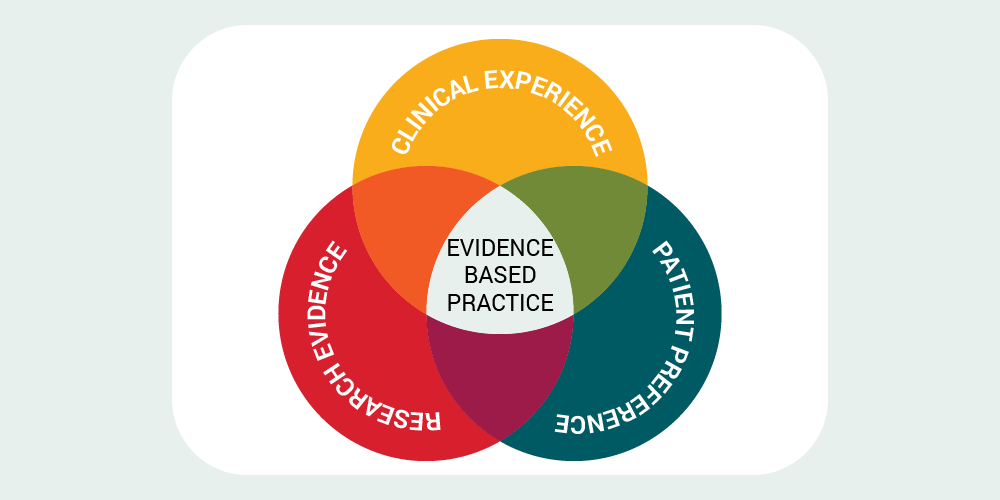Describe the Use of Evidence-based Design in Healthcare Facility Planning
The Role of Evidence-Based Practice in Nursing. This six-course certificate program provides you with in-depth instruction in effectively using evidence-based research to improve.

Evidence Based Design For Healthcare Facilities Health Care Healthcare Design Design
Most experts agreed that the term evidence-influenced design is a more accurate characterization of the approach used in the majority of todays health care settings meaning that decisionmakers must use a combination of research and.

. Evidence based medicine is the conscientious explicit and judicious use of current best evidence in making decisions about the care of individual patients. EDAC Champion and Advocate Firms take an additional step ensuring their healthcare teams become EDAC certified and actively incorporate EBD in their healthcare projects. Evidence Based Design for healthcare settings uses a set of design principles that have been scientifically evaluated and shown to make a positive difference for patient staff and resource outcomes.
Expertise with the best available external clinical evidence from systematic research Sackett et al 1996. USING EVIDENCE-BASED DESIGN PRINCIPLES TO DESIGN 3 thereby providing the best view of the outdoors and a larger family area. Findings from the Pebble Project are expected to advance the evidence base by increasing our knowledge of design features that can ensure a safe healing.
Evidence-based design is a term used to describe how the physical design of health care environments affects patients and staff. Nurses use the principles of evidence-based practice to make optimal decisions about patient care. Constant monitoring which includes monitoring patients decentralized nurses station Carpman Grant Kirchen 2016.
The practice of evidence based medicine means integrating individual clinical. Evidence-Based Design for Healthcare Facilities PDF Spurred by the healthcare building boom Evidence-Based Design for Healthcare Facility design is an important and growing trend in creating safe and nurturing patient-care environments. If done well healthcare facility design and planning can transform your organization and improve safety operations and the bottom line.
Evidence-based practice EBP is the conscientious and judicious use of current best evidence in conjunction with clinical expertise and patient values to guide health care decisions. Evidence-based design EBD is the process of basing decisions about the built environment on credible research to achieve the best possible outcomes. Evidence-based design EBD of healthcare facilities is an emerging field that has the potential to significantly reduce the burden of healthcare-associated infections HAIs.
HFM Daily offers blog coverage by the award-winning HFM editorial team and links to in-depth information on health care design construction engineering environmental services operations and technology. When nurses integrate the best available science into their practice they work from a holistic patient-centered approach. Evidence-based health-care architecture creates safe and therapeutic environments for patient care and encourages family involvement.
Industry have turned to evidence-based planning and design as a means of making more informed decisions about hospital facility designs that can help attract and retain nursing staff improve patient safety and generate high levels of patient satisfaction. The best-known construction and building trends for healthcare facilities revolve around evidence-based designs. Evidence-based design or EBD is a method founded on scientific analysis credible research and other methodologies that determine which environmental factors are most likely to contribute to positive outcomes.
This post outlines how evidence-based practice is used in nursing as well. 45 Key characteristics of evidence-based design in hospital settings include single-patient rooms use of noise-reducing construction materials easily accessible workstations and improved layout for patients and. As well as use of information.
Countries and using some form of evidence-based design to do so. The design also provides the patient with more privacy and the noise from the corridor area are reduced Room typologies 2012. WHAT IS EVIDENCE-BASED DESIGN.
The aim of this study was to describe the organizational decision-making process used in the selection of evidence-based design EBD concepts the criteria used to make these decisions and the extent to which leadership style may have influenced the decision-making process. To achieve the best outcome the design team and health care organization should come to a consensus as to how to leverage EBD into the requirements of the program schedule and budget. According to the Center for Health Design Evidence-Based Design is the process of basing decisions about the built environment on credible research to achieve the best possible outcomes.
Evidence-based practice EBP is the objective balanced and responsible use of current research and the best available data to guide policy and practice decisions such that outcomes for consumers are improved. Evidence Based Design EBD is a way of redirecting goals. 1215 Best evidence includes empirical evidence from randomized controlled trials.
Five research questions were formulated to frame the direction of this study. The Center for Health Design CHD defines EBD as the deliberate attempt to base building decisions on the best available research evidence with the goal of improving outcomes and of continuing to monitor the. The Evidence-Based Design Premise The fundamental premise of evidence-based design is that design of health care facilities that support patient-centered care should be but are often not guided by credible evidence generated through research.
Evidence from other scientific methods such as descriptive and qualitative research. You can read HFM Daily stories on this page or subscribe to Health Facilities Management This Week for a Friday roundup of the weeks posts. Esis the necessary causal relationship is missing thus its not evidence-based.
Above all an optimal patient-centered healthcare environment has the power to improve clinical outcomes. Hospital administrators are continually searching for proven cost-effective strategies to do everything from enhancing patient safety. While the value of evidence-based design EBD is clear consideration should be given to how project teams incorporate it into the normative planning process.

What Is Evidence Based Practice

Evidence Based Design Practice Human Response And Interior Design Design Theory Visual Communication Design Healthcare Design

Pin By Kim Purnell On Cra Recruitment Clinical Trials Clinical Research
Comments
Post a Comment